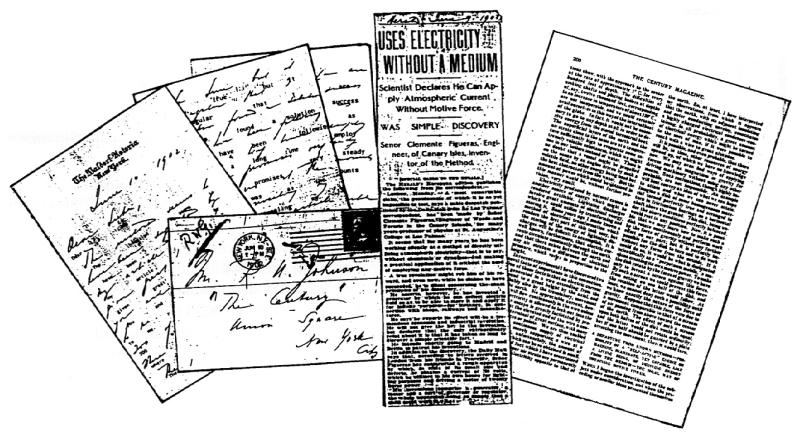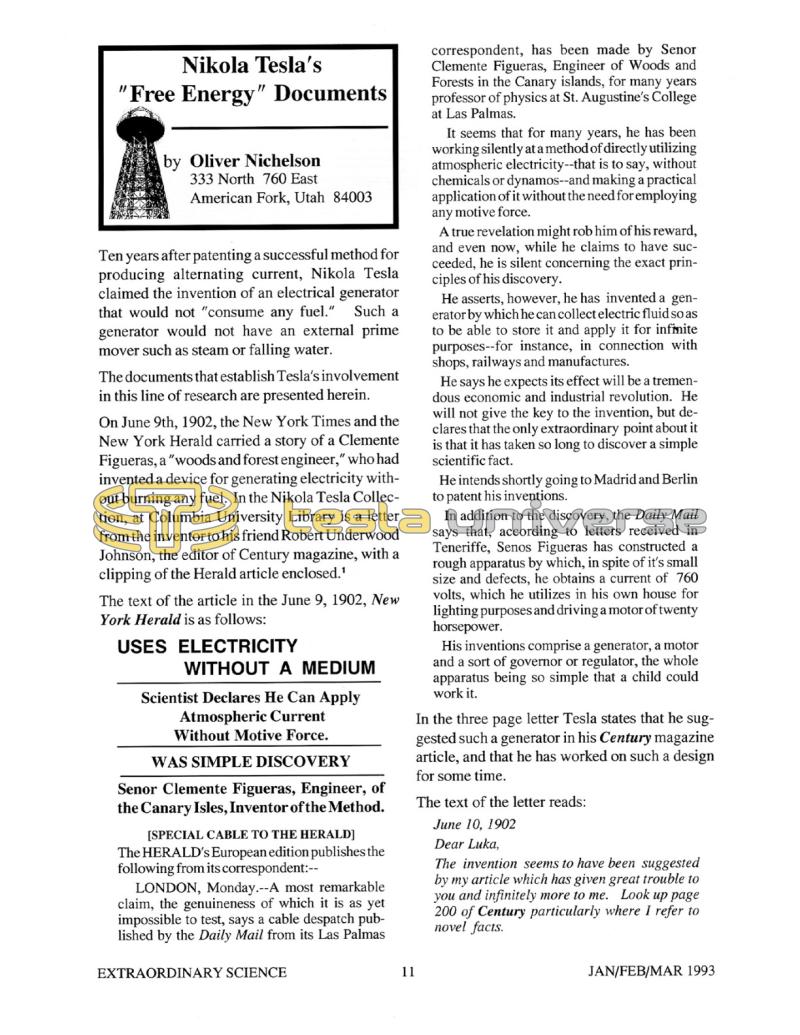
Nikola Tesla Articles
Nikola Tesla's “Free Energy” Documents
Ten years after patenting a successful method for producing alternating current, Nikola Tesla claimed the invention of an electrical generator that would not “consume any fuel.” Such a generator would not have an external prime mover such as steam or falling water.
The documents that establish Tesla’s involvement in this line of research are presented herein.
On June 9th, 1902, the New York Times and the New York Herald carried a story of a Clemente Figueras, a “woods and forest engineer,” who had invented a device for generating electricity without burning any fuel. In the Nikola Tesla Collection, at Columbia University Library is a letter from the inventor to his friend Robert Underwood Johnson, the editor of Century magazine, with a clipping of the Herald article enclosed.1
The text of the article in the June 9, 1902, New York Herald is as follows:
USES ELECTRICITY WITHOUT A MEDIUM
Scientist Declares He Can Apply Atmospheric Current Without Motive Force.
WAS SIMPLE DISCOVERY
Senor Clemente Figueras, Engineer, of the Canary Isles, Inventor of the Method.
[SPECIAL CABLE TO THE HERALD]
The HERALD’s European edition publishes the following from its correspondent:-
LONDON, Monday. - A most remarkable claim, the genuineness of which it is as yet impossible to test, says a cable despatch published by the Daily Mail from its Las Palmas correspondent, has been made by Senor Clemente Figueras, Engineer of Woods and Forests in the Canary islands, for many years professor of physics at St. Augustine’s College at Las Palmas.
It seems that for many years, he has been working silently at a method of directly utilizing atmospheric electricity - that is to say, without chemicals or dynamos - and making a practical application of it without the need for employing any motive force.
A true revelation might rob him of his reward, and even now, while he claims to have succeeded, he is silent concerning the exact principles of his discovery.
He asserts, however, he has invented a generator by which he can collect electric fluid so as to be able to store it and apply it for infinite purposes - for instance, in connection with shops, railways and manufactures.
He says he expects its effect will be a tremendous economic and industrial revolution. He will not give the key to the invention, but declares that the only extraordinary point about it is that it has taken so long to discover a simple scientific fact.
He intends shortly going to Madrid and Berlin to patent his inventions.
In addition to the discovery, the Daily Mail says that, according to letters received in Teneriffe, Senos Figueras has constructed a rough apparatus by which, in spite of its small size and defects, he obtains a current of 760 volts, which he utilizes in his own house for lighting purposes and driving a motor of twenty horsepower.
His inventions comprise a generator, a motor and a sort of governor or regulator, the whole apparatus being so simple that a child could work it.
In the three page letter Tesla states that he suggested such a generator in his Century magazine article, and that he has worked on such a design for some time.
The text of the letter reads:
June 10, 1902
Dear Luka,
The invention seems to have been suggested by my article which has given great trouble to you and infinitely more to me. Look up page 200 of Century particularly where I refer to novel facts.
The report is not[?] likely to be true but it is singular that I have also found a solution which I have been following up since a long time and which promises very well. I was at the point of revealing my method in the article but you pressed[?] me to find[?] that I did not have enough energy left to do it. I am glad now.
The conditions at the Pic of Teneriffe are ideal for the success of such methods as I contemplate to employ for getting a steady supply of small amounts of energy.
Sorry I was unable to call.
Nikola
In the Nikola Tesla Collection, at Columbia University Library is a letter from the inventor to his friend Robert Underwood Johnson, the editor of Century magazine, with a clipping of the Herald article enclosed. These articles combined with a copy of page 200 of June 1900 Century magazine (“Problem of Increasing Human Energy”) gives exciting new insight in to Tesla’s thoughts of alternate energy sources.
The aforementioned text on page 200 from Tesla’s June 1900 Century article is extracted below. Tesla once called this article the most important that he wrote. The “novel facts” citation mentioned in the letter is found in the first column, next to the last paragraph, first sentence.2 Discussion of the novel facts just precedes the article’s subsection dealing with a “Self-Acting Machine...Capable...of Deriving Energy From the Medium.”
The extracted text of Tesla’s article - The Problem of Increasing Human Energy - published in the June 1900 Century magazine is as follows:
In recent experiments I have discovered two novel facts of importance in this connection. One of these facts is that an electric current is generated in a wire extending from the ground to a great height by the axial and probably also by the translatory, movement of the earth. No appreciable current, however, will flow continuously in the wire unless the electricity is allowed to leak out into the air. Its escape is greatly facilitated by providing at the elevated end of the wire a conducting terminal of great surface, with many sharp edges or points. We are thus enabled to get a continuous supply of electrical energy by merely supporting a wire at a great height, but, unfortunately, the amount of electricity which can be so obtained is small.
The second fact which I have ascertained is that the upper air strata are permanently charged with electricity opposite to that of the earth. So at least, I have interpreted my observations, from which it appears that the earth, with its adjacent insulating and outer conducting envelop, constitutes a highly charged electrical condensor - containing, in all probability, a great amount of electrical energy which might be turned to the uses of man, if it were possible to reach with a wire to great altitudes.
It is possible, and even probable that there will be, in time, other resources of energy opened up, of which we have no knowledge now. We may even find ways of applying forces such as magnetism or gravity for driving machinery without using any other means. Such realization, though highly improbable, are not impossible. An example will best convey an idea of what we can hope to attain and what we can never attain. Imagine a disk of some homogeneous material turned perfectly true and arranged to turn in frictionless bearings on a horizontal shaft above the ground This disk, being under the above conditions perfectly balanced, would rest in any position. Now, it is possible that we may learn how to make such a disk rotate continuously and perform work by the force of gravity without any further effort on our part; but it is perfectly impossible for the disk to turn and do work without any force from the outside. If it could do so, it would be what is designated scientifically as a “perpetuum mobile,” a machine creating its own motive power. To make the disk rotate by the force of gravity we have only to invent a screen against this force. By such a screen we could prevent this force from acting on one half of the disk, and the rotation of the latter would follow. At least, we cannot deny the possibility until we know exactly the nature of the force of gravity. Suppose that this force were due to a movement comparable to that of a stream of air passing from above toward the center of the earth. The effect of such a stream upon both halves of the disk woud be equal, and the latter would not rotate ordinarily; but if one half should be guarded by a plate arresting the movement, then it would turn.
A careful examination of the article reveals the inventor believed his design for an electrical generator which is its own prime mover, that is, does not “consume any fuel,” would not violate the energy conservation principle. Tesla believed, rather, that his design transformed one form of energy into another.
NOTES:
- The Tesla-Johnson letter and Herald clipping are used with permission of the Nikola Tesla Collection, Rare Book and Manuscript Library, Columbia University, New York City.
- An analysis of the inventions intended by Tesla in this letter is found in: Nichelson, Oliver, “Nikola Tesla’s Later Energy Designs,” IECEC Conference, Boston, August 1990. It is available from the author with patents for $6.

